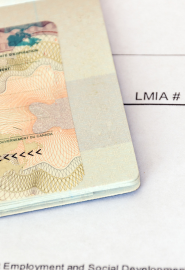The LMIA process can be complex, time-consuming, and requires employers to provide thorough documentation. For businesses looking to hire foreign workers, obtaining an LMIA is a vital step. In certain cases, employers must advertise the position and potentially interview Canadian candidates before hiring a foreign worker.
Additionally, there are high-wage and low-wage categories for LMIA applications, depending on the offered salary compared to the provincial or territorial median wage. Some work permit types are LMIA-exempt and fall under the International Mobility Program.

- The employer must be a legitimate Canadian business with the ability to meet the requirements of the LMIA process.
- The employer must be willing to hire a temporary foreign worker and provide employment conditions that comply with Canadian labor standards.
2. Job Advertisement:
- Employers are generally required to advertise the job position for at least four weeks. This advertisement must be conducted through a recognized method (e.g., job boards, newspapers, etc.) to prove that no qualified Canadian citizen or permanent resident was available for the job.
3. Salary and Job Type:
- Positions are classified as high-wage or low-wage based on the provincial/territorial median wage. High-wage employees are paid at or above the median wage, while low-wage employees are paid below the median.
4. Documentation:
- Employers must provide comprehensive documentation detailing why Canadian applicants were not hired for the position and must prove that no Canadian citizens or permanent residents were qualified for the job.
5. Employer’s Ability to Support:
- The employer must demonstrate the ability to provide basic support for the foreign worker, including a safe working environment and compliance with labor laws.

- Before starting the process, determine whether an LMIA is required. Some work permits may be exempt from the LMIA requirement under the International Mobility Program.
2. Advertise the Job Position:
- Advertise the job for at least four weeks through recognized channels (e.g., job boards, newspapers, etc.). This is necessary to show that qualified Canadian workers are unavailable.
3. Apply for LMIA:
- Complete and submit the LMIA application to Employment and Social Development Canada (ESDC). Ensure all required details and supporting documents are included in the application.
4. Provide Necessary Documentation:
- Submit supporting documents explaining why Canadian citizens or permanent residents were not hired for the job. Provide evidence of your advertising efforts and any interviews conducted.
5. Wait for Decision:
- The ESDC will review the application and issue a decision. This can take several weeks or even months, depending on the complexity of the case.
6. Positive LMIA:
- If the LMIA is approved, the employer will receive a positive LMIA, which allows them to hire a temporary foreign worker for the position.
7. Issue Work Permit:
- Once the employer has received a positive LMIA, the foreign worker can use it to apply for a work permit to enter Canada and begin employment.

1. Employer’s Information:
- Business license or registration.
- Proof of the company’s legal status.
- Financial information or evidence that the business can financially support a foreign worker.
2. Job Advertisement Records:
- Proof of the job advertisement for at least four weeks, including dates, platforms used, and a description of the recruitment efforts made.
3. Job Description:
- Detailed job description outlining duties, responsibilities, salary, and working conditions.
4. Reasons for Not Hiring Canadians:
- Documentation explaining why Canadian candidates were not suitable for the position (e.g., skills mismatch, lack of experience).
5. Employee Salary Information:
- Proof of the salary offered to the foreign worker and its comparison to the provincial or territorial median wage.
6. Employer’s Statement:
- A letter or statement from the employer explaining the need for a foreign worker and the terms of employment.
7. Additional Documents:
- Any other documents requested by Employment and Social Development Canada (ESDC) based on the job type or wage category.

- High-wage LMIA applications are for positions that offer a salary at or above the provincial/territorial median wage, while low-wage applications are for positions paying below that threshold.
2. Do I need an LMIA for every type of work permit?
- No, not all work permits require an LMIA. Some workers may be exempt from needing an LMIA if their position falls under the International Mobility Program.
3. How long does it take to get a positive LMIA?
- The processing time for an LMIA application can take several weeks to a few months, depending on the complexity of the application and the volume of requests being processed.
4. Can I hire a foreign worker without advertising the job for four weeks?
- Generally, the advertisement period is required. However, there may be exceptions in certain cases. It’s essential to check if your specific situation qualifies for an exemption or expedited process.
5. What happens if my LMIA is denied?
- If your LMIA application is denied, you can either reapply with additional documentation or review the reasons for the refusal. You may also need to make adjustments to your recruitment process.
6. Is there any way to speed up the LMIA process?
- The LMIA process can take time, but ensuring your application is complete and well-documented can help avoid delays. Some employers may be eligible for expedited processing under certain circumstances, such as for high-demand jobs or workers in critical sectors.
